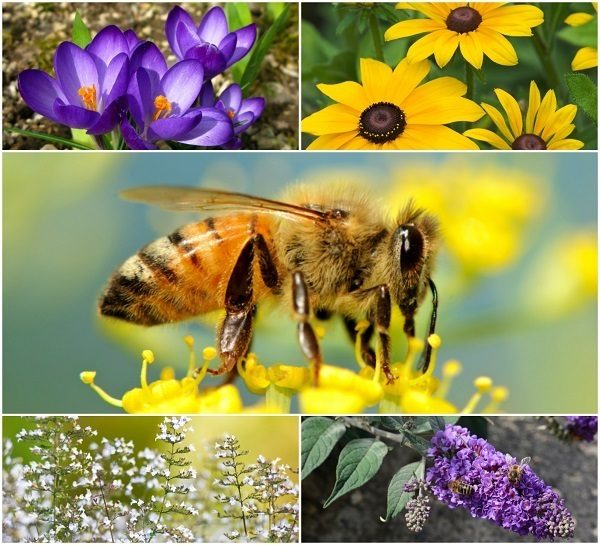
Bees, not just the honeybees, but bumblebees, soldier bees, carpenter bees, mason bees, sweat bees and several thousand other types, are essential to sustain our lives.
One-third of the plants that provide us with food, especially vegetables and fruits, are pollinated by them. Bees and many flowering plants have co-evolved, so they need one another to survive; some flowers need particular kinds of bees for effective pollination and these bees need the nectar from these specific types of flowers.
We need the bees to get good yield from the crops in our vegetable gardens and from our fruit trees. Without bees, our agricultural world would be destroyed. However, as we build more cities and try to produce more food through intense agricultural practices, the bees are deprived of their habitat and food sources. The use of pesticides and other environmental pollutants are killing them off too.
Bees do not harm our crops. They are beneficial to us as well as the world around us. We can do our best to protect the environment and ensure our food supply by welcoming these pollinators into our garden.
Related Reading: Here’s Why We Need To Save The Bees + 10 Things You Can Do To Help
Choosing flowering plants for a bee-friendly garden:
To welcome bees into your garden, you should select the kind of flowers that attract them with nectar and pollen. A few things to look for are:
Native flowers
Honeybees may collect nectar from a wide variety of flowers, but many wild bees are partial to native flowers. Many native flowers are now considered weeds, but planting a good selection of such flowers can entice native bees into your garden.
Colorful flowers
Flowers are endowed with beautiful colors to get the attention of pollinators. Bees are more attracted to yellows and white and the blue-purple range.
Fragrant flowers
Flowers carry fragrance for the very purpose of attracting pollinators.
Long bloomers
Plants with a long flowering season assure the bees of a continuous food supply.
Early season flowers
Early spring flowers are a relief to bees that have been on a meager ration during winter.
Mass plantings
Having just one or two plants of a type, however bee-friendly it may be, does not serve the purpose. Instead, plant large patches of the same plant in an area, or have a mixed planting with a few selected bee favorites.
Some beautiful flowers that attract bees:
1. Bee balm (Monarda sp.)
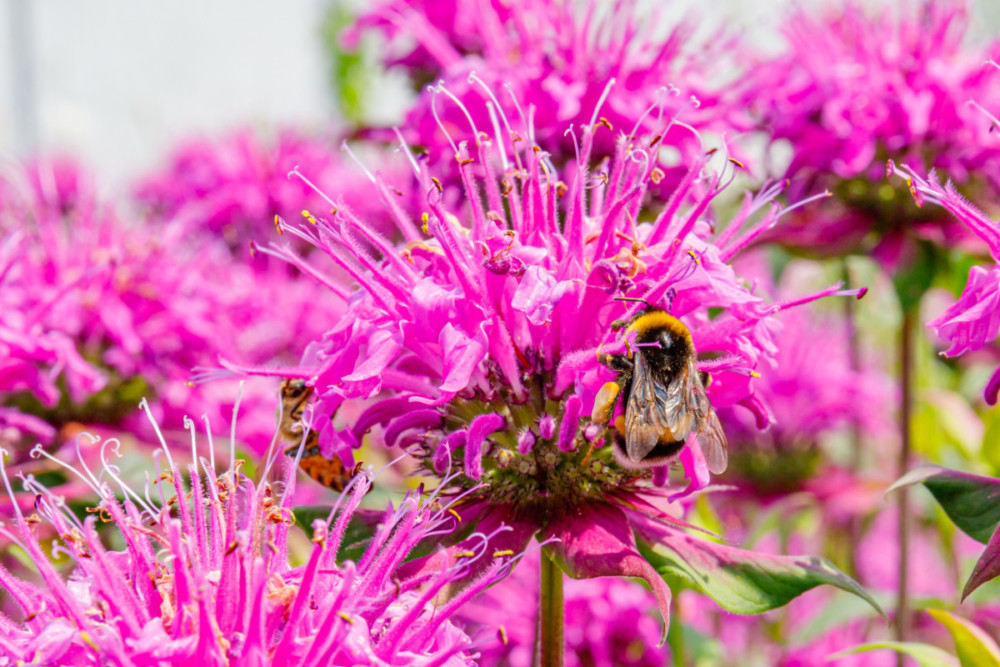
These aptly named North American natives deserve a place in every bee-friendly garden. They readily grow in most parts of the country and flower profusely through summer. For best results, grow them in a sunny part of the garden where plenty of moisture is available.
You have several species to choose from, such as Scarlet bee balm (M. didyma), Lemon bee balm (M.citriodora) or Horse mint (M. fistulosa). With color choices ranging from deep red to various shades of pink and purple, and even white, it wouldn’t be hard to find a bee balm to suit your garden’s color scheme. What’s more, the aromatic leaves and flowers can be used to make an herbal tea. USDA Zones 3-9
2. Blackeyed Susan (Rudbeckia hirta)
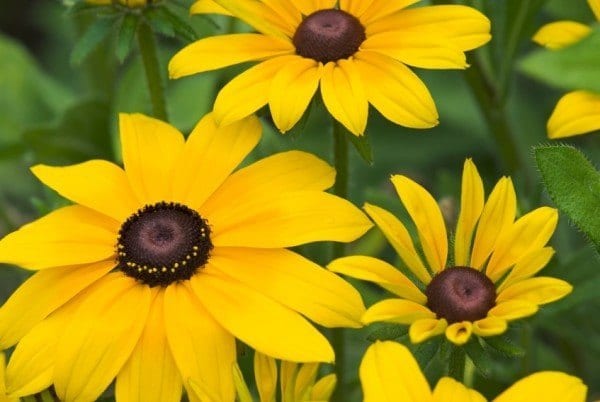
The cheerful Rudbeckia is another North American native popular with bees and other pollinators. Besides the signature sunny yellow with dark centers, the flowers come in bronze, mahogany and red, some having two-tone petals. These perennials are easy to grow and quickly establish themselves in sunny spots, performing well even in poor soil and dry conditions. Give them their own space or plant them in mixed borders at the back of the garden. USDA Zones 4-9
3. Stonecrop (Sedum spp.)
These succulents with showy heads of tiny flowers are easy-care plants with neat habits. Sedums are easily propagated from stem and leaf cuttings and seeds. Once established, they thrive without much mollycoddling, making them the ideal choice for dry areas and lazy gardeners. All they require is good drainage and some sun.
You can find sedums to suit almost any USDA zone. Several cultivars come with flowers in white, yellow, red, and several shades of pink and bronze. Some have interesting leaf coloration as well. Flowering from mid-spring to late fall, the tiny star-shaped flowers attract bees and butterflies when they open. USDA Zones 3-11
4. Goldenrod (Solidago spp.)
It is quite natural for hordes of wild bees to throng to these herbaceous perennials that are natives of the American continents. A feast of nectar and pollen await them in the tiny flowers that make up the golden yellow branching spikes. Mostly considered a weed and falsely thought to cause allergies, goldenrod is not as popular in gardens as they should be. But they can brighten your garden from midsummer to mid-fall, dutifully coming back year after year. USDA Zones 5-10
5. Butterfly Bush – (Buddleja davidii)
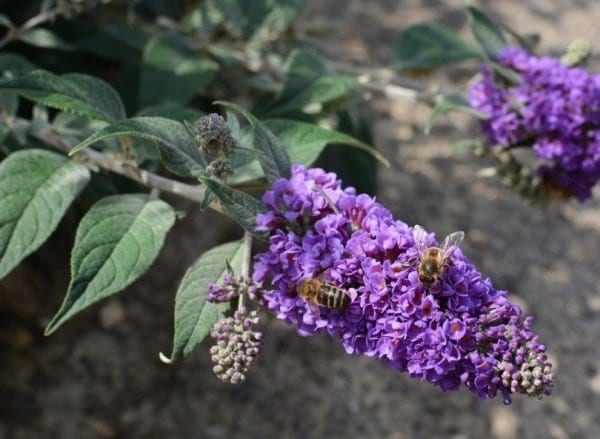
This flowering bush is a butterfly magnet as the name implies, but bees and other nectar lovers like hummingbirds find the long spikes of tiny, fragrant flowers equally attractive. Pink and purple are the most common flower colors, but you can get them in blue, lavender, orange, cream, and white as well.
Depending on your zone, you can grow this perennial as a bush or a small tree, but pruning is necessary to promote profuse flowering. It loves sun, but can do well in partial shade. USDA Zones 5-9
6. Purple coneflower (Echinacea purpurea)
This perennial native to the eastern United States is guaranteed to draw bees and butterflies to your garden all through its flowering season extending from midsummer to late fall. The pink-purple flowers are used for preparing cold and flu remedies, so it is an additional reason to plant them in your garden.
You can start your plants from seeds or seedlings initially, but established clumps can be divided in spring to increase your collection. These tall plants tolerant of poor soil and dry conditions can be planted at the back of the garden where their large, showy flowers would form a backdrop to more delicate flowers in the foreground. USDA Zones 3-9
7. Joe-pye weed (Eutrochium purpureum)
Although called a weed, the large pink and purple flower heads of this North American perennial is not only attractive to bees but looks spectacular in any garden that can accommodate them. There are white-flowered varieties too.
Joe-pye weed is best grown from stem cuttings taken in early spring, or root cuttings in fall when the top growth dies down. They prefer sunny locations but do well in partial shade too. Often reaching 5-7 feet, the plants are best suited for the back of the garden. When planted in moist soil, they form large clumps that get larger every year and put up a flower show from July to September. USDA Zones 4-9
8. Lavender (Lavendula augustifolia)
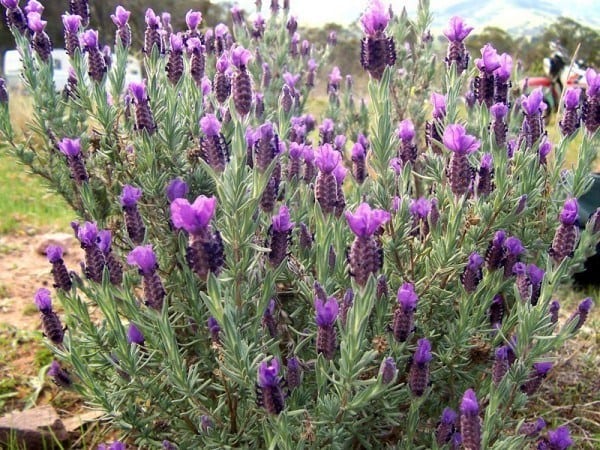
This aromatic plant of European origin is now popular in temperate regions around the world. Besides attracting bees, the pretty lavender blooms that come out from late spring to summer can perfume the home and garden and flavor your dishes. Purple-colored blooms may be the most well-known, but they also come in pink and white.
Although lavender is a perennial herb in mild climates, it is grown as an annual elsewhere. It is a low-maintenance plant that tolerates drought and poor soil. They do well in containers as well as in the ground as long as they have enough sunlight and good drainage. No garden where lavender can grow should be without it. USDA Zones 4-10
Read More: The Total Guide To Growing, Harvesting & Using Lavender
9. Snowdrops (Galanthus spp.)
One of the first flowers to appear in late winter to early spring, the snowdrops do not often wait for the snow to melt away. And the bees that have nearly emptied their winter reserves can hardly wait for their arrival. Attract them to your garden with a patch of snowdrops naturalized in the landscape.
Snowdrops do well in partial shade and love humus-rich soil, so they are a great choice under trees that shed their leaves. Massed planting are particularly effective when all the little nodding flowers make a white carpet under them in early spring. You can plant the tiny bulbs in fall, in rich, well draining soil and keep the moisture in with leaf mulch. USDA Zones 3-8
10. Crocus (Crocus spp.)
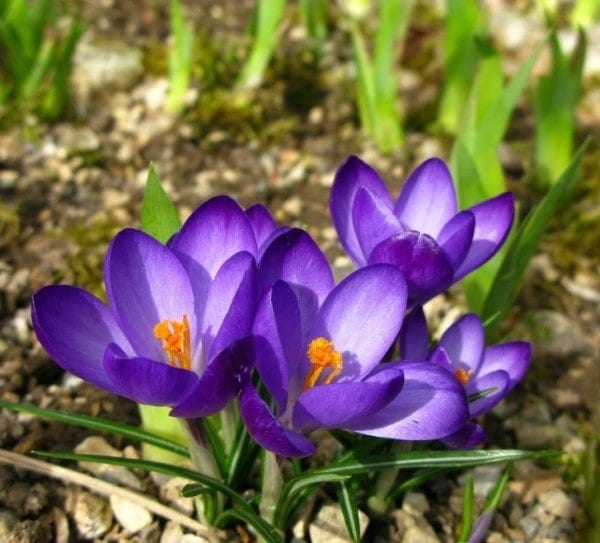
This is another early flowering bulb that can provide the much needed sustenance to bees. Coming out in jewel-like blues and purples and cheery yellows, these little flowers can have a great impact on the bees as well as the landscape.
Plant the bulbs 4 inches deep in early fall and provide sufficient water. You would need a large number of bulbs to make an impact, but they don’t need much care once established. Choose varieties with staggered blooming time to extend the show. USDA Zones 3-8
11. Chives (Allium schoenoprasum)
Whether you plant this onion relative in your flowerbed or vegetable patch, bees would flock to its purple flower heads. This is a great choice for people who are allergic to the aster family of flowers but still want to welcome bees into their garden.
You can raise chives from seeds or grow it from divisions. Plant them in early spring, in rich, moist, well-draining soil. You can use the leaves as herb and leave the flowers for the bees, but remove the flower heads before they set seed. USDA Zones 3-10
12. Sunflowers (Helianthus spp.)
Sunflowers with their large central discs provide ample opportunity for bees to forage for nectar and pollen. You can grow native sunflower species almost anywhere in the country as long as they are planted after the last frost. While annual sunflowers (H. annum) are preferred as ornamentals and for seeds, perennial sunflowers such as sunchokes (H.tuberosus) can be grown for their edible tubers, but they can be invasive in some areas. USDA Zones 3-10
13. Roses
Bees are attracted to some roses, but not all. Single-petal roses and old-fashioned fragrant roses with open centers are what you should look for. If you can see the tuft of stamens at the center of the flower clearly, they are visible to the bees too. Most rugosa and sweetbriar roses that develop rosehips are pollinated by bees. Fragrant ‘James Mason’ and ‘Carefree Beauty’ are also bee favorites. USDA Zones 4-10
14. Catmint (Nepeta spp.)
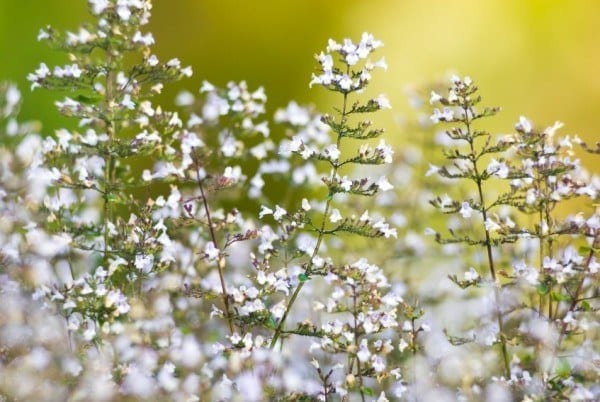
Catmint is not just for cats; bees are just as crazy about these fragrant flowers that cover the plant in summer and fall. The drought tolerant and deer resistant perennial is free-flowering and low-maintenance. The flowers can be pink, blue, purple or white. Some varieties have attractive grey, gold or chartreuse foliage. You can hardly find any valid reason not to grow it in the garden.
Plant catmint in a sunny spot and cut back after the first flush of flowering. Get different varieties to extend the flowering season. USDA Zones 3-9
15. Cranesbills (Geranium spp.)
These hardy geraniums with really long flowering season right from early spring until the frosty days of winter make them a winner in the bee garden. The pretty blooms in pink, purple or white keeps coming, inviting them to make regular visits.
Grow cranesbills in partial sun or light shade. They like regular watering, but not water logging. Some can withstand occasional dry spells. An occasional pruning keeps the plant in good shape. Cut back when the plants start to decline as the temperature dips. USDA Zones 4-10
16. Salvia (Salvia spp.)
Salvias and bees are made for each other. Their tiny flowers on long spikes carry quite a bit of nectar to attract all the bees in the neighborhood. When these herbaceous plants are covered in pink and purple flowers, the buzzing of bees can be heard from far away.
Salvias are easy to grow from seeds, and their wide color range includes white, apricot and reds besides the pink and blue spectrum. The plants thrive in summer heat and continue to flower through fall. You can find salvias suitable for any USDA zone above 5. USDA Zones 5-10
17. Butterfly weed (Asclepias tuberosa)
This perennial milkweed with yellow-orange flowers is native to North America and play host to the monarch butterfly larvae. But that doesn’t keep away the bees. In fact, several types of native bees throng the nectar-rich flowers throughout the day, competing with the butterflies and hummingbirds visiting them.
Butterfly weed is easily raised from seed, although it may take a couple of years for the seedlings to come into flower. However, they faithfully re bloom for many years to come. USDA Zones 3-9
18. Common Heliotrope (Heliotropium spp.)
This flowering plant with clusters of tiny, deep blue and purple, fragrant blooms held atop deeply veined foliage is a bee favorite. The vanilla scented flowers are a delight in any garden, but the plants are not cold hardy. They have to be grown as an annual in all but USDA Zones 10 and 11 where they grow as a perennial and attain good size.
Plant them in rich, moist soil and partial sun. The flowers keep coming throughout the growing season as long as the older flowers are removed. Pink and white cultivars are also available. USDA Zones 10-11
19. Cosmos (Cosmos bipinnatus/ C. sulphureus)
Bees love these easy-care annuals that can be used to fill any unattended part of the garden with color and life. The lacy leaves are just as pretty as the flowers that appear in loose spikes. C. bipinnatus is a Mexican native bearing flowers in white and various shades of pink while C. sulphureus has yellow spectrum, from lemon yellow to deep orange.
The plants are easily grown from seeds which can be sown in situ in warm areas, but ideally started indoors in colder regions. Once established, the seedlings are undemanding, but deadheading helps extend the growing season. USDA Zones 9-11
20. Blanket flower (Gaillardia x grandiflora)
These tough, drought-resistant plants with a profusion of daisy-like flowers can provide sustenance for bees in gardens many other flowers shy away from. The plants are easily started from seeds and self sows freely in suitable climates. Starting from early summer, the flowering continues into fall. The showy flowers come in solid yellows, oranges, rust and burgundy, and with bicolor and tricolor petals. Plant then in dry sunny areas like rock gardens and deadhead frequently to keep them in good form. USDA Zones 3-10
Not only these ornamentals but most fruit trees and herbs have flowers irresistible to bees. Keeping your garden free of pesticides and other chemical pollutants would go a long way in providing a safe haven for bees and other pollinators.
